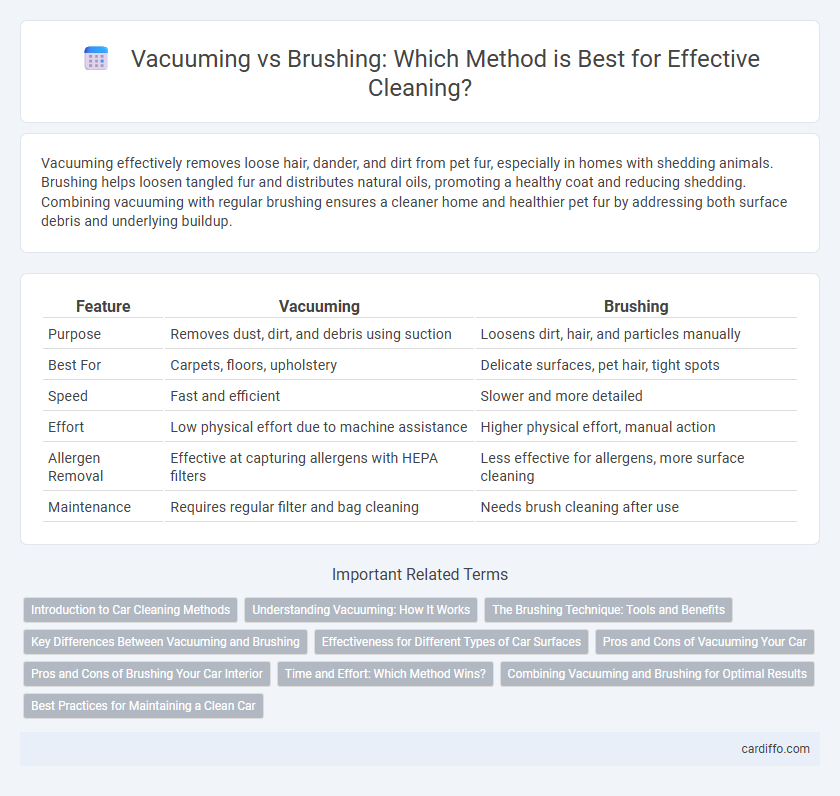Vacuuming effectively removes loose hair, dander, and dirt from pet fur, especially in homes with shedding animals. Brushing helps loosen tangled fur and distributes natural oils, promoting a healthy coat and reducing shedding. Combining vacuuming with regular brushing ensures a cleaner home and healthier pet fur by addressing both surface debris and underlying buildup.
Table of Comparison
| Feature | Vacuuming | Brushing |
|---|---|---|
| Purpose | Removes dust, dirt, and debris using suction | Loosens dirt, hair, and particles manually |
| Best For | Carpets, floors, upholstery | Delicate surfaces, pet hair, tight spots |
| Speed | Fast and efficient | Slower and more detailed |
| Effort | Low physical effort due to machine assistance | Higher physical effort, manual action |
| Allergen Removal | Effective at capturing allergens with HEPA filters | Less effective for allergens, more surface cleaning |
| Maintenance | Requires regular filter and bag cleaning | Needs brush cleaning after use |
Introduction to Car Cleaning Methods
Vacuuming effectively removes loose dirt, dust, and debris from car interiors, targeting carpets, seats, and crevices for a thorough clean. Brushing, especially with specialized car brushes, dislodges stubborn particles and dirt trapped in fabric fibers and tight spaces, enhancing the overall cleanliness of upholstery. Combining vacuuming and brushing optimizes interior car cleaning by ensuring both surface and deep-seated debris are efficiently addressed.
Understanding Vacuuming: How It Works
Vacuuming operates by creating suction to lift dirt, dust, and debris from surfaces, using an electric motor to generate airflow through a hose and filter system. The efficiency of vacuuming depends on factors such as motor power measured in watts, airflow in cubic feet per minute (CFM), and the quality of the vacuum's filtration system, including HEPA filters for capturing fine particles. Vacuuming excels at deep cleaning carpets and hard floors by extracting embedded particles that brushing alone often leaves behind.
The Brushing Technique: Tools and Benefits
The brushing technique in cleaning employs specialized tools such as soft-bristle brushes and vacuum brush attachments to effectively dislodge dirt and pet hair from carpets and upholstery. This method enhances deep cleaning by reaching areas where vacuum suction alone may be insufficient, improving the overall cleanliness and extending the life of fabrics. Utilizing brushes with varying stiffness allows for customized cleaning, ensuring delicate surfaces remain undamaged while stubborn debris is removed efficiently.
Key Differences Between Vacuuming and Brushing
Vacuuming utilizes suction power to efficiently remove dirt, dust, and debris from carpets and hard floors, making it ideal for deep cleaning and allergen removal. Brushing employs manual or mechanical bristle action to dislodge surface dirt, pet hair, and crumbs, often enhancing fabric texture but lacking the comprehensive debris extraction of vacuuming. Key differences lie in vacuuming's ability to capture fine particles and allergens through filters, whereas brushing primarily targets visible dirt and requires more physical effort for thorough cleaning.
Effectiveness for Different Types of Car Surfaces
Vacuuming excels at removing loose dirt and debris from carpeted car surfaces and fabric upholstery, providing deep cleaning in textured areas where particles hide. Brushing enhances the effectiveness on leather and smooth surfaces by loosening stubborn dust and dirt, improving the overall cleanliness without damaging delicate materials. For mixed interior surfaces, combining vacuuming with a soft brush ensures optimal removal of contaminants and maintains the texture and appearance of various car materials.
Pros and Cons of Vacuuming Your Car
Vacuuming your car efficiently removes dirt, pet hair, and debris from upholstery and carpets, enhancing interior cleanliness and air quality. However, vacuuming may miss fine dust in tight crevices and requires access to a power source or battery, limiting convenience in some situations. Compared to brushing, vacuuming offers deeper cleaning but may need multiple attachments to address different surfaces effectively.
Pros and Cons of Brushing Your Car Interior
Brushing your car interior effectively removes dirt and debris from fabric surfaces, preventing dust buildup and maintaining upholstery texture. However, excessive brushing can cause wear on delicate materials and may not be as efficient in deep-cleaning compared to vacuuming. Regular use of a soft-bristle brush preserves fabric integrity while enhancing overall cleanliness.
Time and Effort: Which Method Wins?
Vacuuming significantly reduces cleaning time by efficiently removing dirt and debris with minimal effort, making it ideal for large areas and carpets. Brushing requires more manual labor and longer durations, especially on textured or high-pile surfaces, but can target stubborn spots more precisely. For quick, thorough cleaning, vacuuming consistently outperforms brushing in both speed and ease.
Combining Vacuuming and Brushing for Optimal Results
Combining vacuuming and brushing enhances cleaning efficiency by removing embedded dirt and surface debris effectively. Vacuuming captures dust and allergens from deeper carpet fibers, while brushing loosens stubborn particles and pet hair, ensuring a thorough clean. This dual approach promotes a healthier indoor environment and extends the lifespan of flooring materials.
Best Practices for Maintaining a Clean Car
Vacuuming effectively removes dust, dirt, and debris from car carpets and seats, preventing buildup that can cause stains and odors. Brushing dislodges embedded particles and pet hair, especially from fabric upholstery, enhancing vacuum efficiency and maintaining fabric texture. Regularly combining vacuuming with brushing extends the interior's cleanliness and preserves the car's overall appearance.
Vacuuming vs Brushing Infographic

 cardiffo.com
cardiffo.com